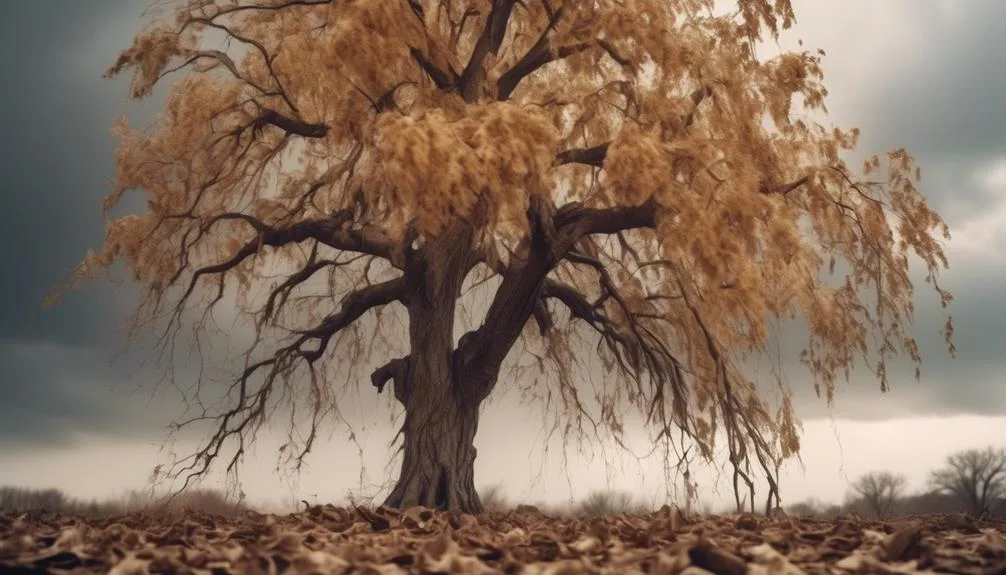The majestic elm trees in your neighborhood or local parks may be at risk due to climate change. As the climate shifts, the conditions that have supported these iconic trees for centuries are also changing.
Understanding how climate change affects elm trees is crucial for their survival and the health of our ecosystems. What is at stake for these beloved trees, and what can be done to ensure their continued presence in our landscapes?
Elm Trees and Climate Change
As climate change continues to impact the environment, elm trees are facing significant challenges that require our attention and action. Elm tree diseases, such as Dutch elm disease and elm yellows, have devastated populations worldwide. Climate change has exacerbated the spread of these diseases by creating conditions that are more favorable for the pathogens responsible for these illnesses.
Additionally, tree genetics play a crucial role in determining the susceptibility of elm trees to these diseases, making it essential to promote genetic diversity in elm populations. Research into disease-resistant tree varieties and the implementation of genetic conservation programs are vital steps in mitigating the impact of climate change on elm trees.
Impact of Climate Change on Elm Trees
Elm trees are experiencing significant impacts from climate change, leading to heightened susceptibility to diseases such as Dutch elm disease and elm yellows, ultimately threatening their populations worldwide.
Climate change affects elm trees in various ways. Changes in temperature and precipitation patterns can disrupt the delicate balance of elm tree biology, affecting their growth, reproduction, and overall health. Warmer temperatures can create more favorable conditions for the spread of diseases and pests that specifically target elm trees, further weakening their resilience.
Additionally, extreme weather events, such as storms and droughts, can directly damage elm trees and make them more vulnerable to infections.
These climate change effects are exacerbating the existing challenges faced by elm trees, necessitating proactive measures to mitigate the impacts and ensure the preservation of these iconic trees.
Adaptation of Elm Trees to Climate Change
Adapting to the changing climate presents a critical challenge for elm trees. It requires innovative strategies to ensure their continued survival and resilience in the face of escalating environmental pressures.
Genetic diversity plays a crucial role in the adaptation of elm trees to climate change. It allows for the selection of individuals with traits that are better suited to changing environmental conditions. By maintaining a diverse gene pool, elm populations have a better chance of coping with new challenges.
Additionally, enhancing drought tolerance in elm trees is vital for their adaptation to climate change. Selective breeding and genetic engineering are being explored to develop elm varieties with improved water-use efficiency and resilience to drought stress. These strategies enable them to thrive in increasingly arid conditions.
Threats to Elm Trees From Climate Change
Facing climate change, elm trees encounter a myriad of threats that jeopardize their long-term survival and ecological significance.
One of the primary concerns is the impact of changing climatic conditions on elm tree resilience. Increasing temperatures and altered precipitation patterns can make elm trees more susceptible to diseases and pests, such as Dutch elm disease and elm leaf beetle.
Additionally, as the climate shifts, suitable habitats for elm trees may move, leading to challenges in their migration and adaptation. Climate change can also disrupt the delicate balance of ecosystems, affecting the availability of necessary resources for elm trees. This can further hinder their ability to thrive in their natural habitats.
Understanding these threats is crucial for developing effective strategies to mitigate the potential negative impacts of climate change on elm tree populations.
Conservation Efforts for Elm Trees
Conservation efforts for elm trees aim to safeguard their future and preserve their vital role in ecosystems amidst the challenges posed by climate change. The following strategies are instrumental in the conservation of elm trees:
- Disease Management: Implementing effective disease management strategies is crucial in protecting elm trees from devastating diseases such as Dutch elm disease.
- Genetic Diversity Preservation: Preserving genetic diversity through seed banks and selective breeding programs can enhance the resilience of elm trees against climate change and tree diseases.
- Habitat Restoration: Restoring and conserving natural habitats where elm trees thrive is essential for their long-term survival and overall ecosystem health.
- Public Awareness and Education: Raising awareness about the importance of elm trees and educating the public on conservation practices can garner support for their protection and preservation.
These conservation efforts are vital in ensuring the survival of elm trees in the face of climate change and tree diseases.
Conclusion
In light of the challenges posed by climate change, efforts to support elm trees' resilience are underway.
Understanding their vulnerability and implementing conservation strategies is pivotal for preserving these iconic trees.
Continued monitoring and support will be essential for ensuring the long-term survival of elm tree populations.
How we adapt and care for these trees will shape the landscape for generations to come.

My interest in trees started when I first saw the giant sequoias in Yosemite.
I was a teenager then, and I remember thinking, “I need to learn more about this.”
That moment stuck with me.
A few years later, I went on to study forestry at Michigan Tech.
Since graduating, I’ve worked in a mix of hands-on tree care and community education.
I’ve spent over ten years helping people understand how to plant, maintain, and protect the trees in their neighborhoods.
I don’t see trees as just part of the landscape.
They are living things that make a real difference in our daily lives.
